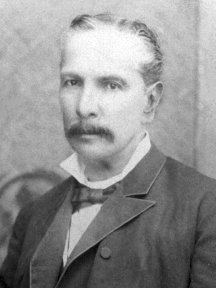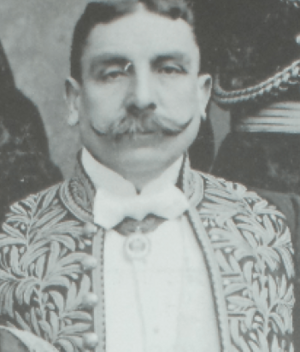Mariano Baptista facts for kids
Quick facts for kids
Mariano Baptista
|
|
|---|---|
 |
|
| 23rd President of Bolivia | |
| In office 11 August 1892 – 19 August 1896 |
|
| Vice President | Severo Fernández Vacant |
| Preceded by | Aniceto Arce |
| Succeeded by | Severo Fernández |
| 6th Vice President of Bolivia | |
|
First Vice President
|
|
| In office 4 September 1884 – 15 August 1888 Serving with Jorge Oblitas
|
|
| President | Gregorio Pacheco |
| Preceded by | Aniceto Arce |
| Succeeded by | José Manuel del Carpio |
| Minister of Foreign Affairs and Worship | |
| In office 23 October 1888 – 26 January 1891 |
|
| President | Aniceto Arce |
| Preceded by | Juan Francisco Velarde |
| Succeeded by | Serapio Reyes Ortiz |
| Minister of Foreign Affairs and Government | |
| In office 9 May 1873 – 4 May 1876 |
|
| President | Adolfo Ballivián Tomás Frías |
| Preceded by | Melchor Terrazas |
| Succeeded by | Jorge Oblitas |
| Minister of Finance | |
| In office 12 August 1873 – 27 September 1873 |
|
| President | Adolfo Ballivián |
| Preceded by | Rafael Bustillo |
| Succeeded by | Pantaleón Dalence |
| Personal details | |
| Born |
Mariano Baptista Caserta
16 July 1831 Calchani, Cochabamba, Bolivia |
| Died | 19 March 1907 (aged 74) Cochabamba, Bolivia |
| Political party | Conservative |
| Spouse | Gabina Terrazas |
| Parents | José Manuel Baptista Petrona Caserta |
| Education | University of Saint Francis Xavier |
| Signature | |
Mariano Baptista Caserta (born July 16, 1832 – died March 19, 1907) was an important Bolivian leader. He was a politician, a great speaker, and a journalist. He served as the 23rd President of Bolivia from 1892 to 1896. Before that, he was the Vice President and also worked as the Minister of Foreign Affairs. He was known as a very smart person for his time.
Contents
Early Life and Career
Growing Up and Studying
Mariano Baptista was born in Calchani, Cochabamba, Bolivia. His parents were José Manuel Baptista and Petrona Caserta. He studied law at the Universidad Mayor, Real y Pontificia de San Francisco Xavier de Chuquisaca. Even when he was young, he was known for being a talented speaker. He earned his law degree in 1857, but he never worked as a lawyer.
From a young age, Baptista also worked in journalism. He started and led a newspaper called El Porvenir de Sucre in 1855. He was a strong Catholic and even directed the Cochabamba Seminary. He also taught history and literature there.
Starting in Politics
In 1855, when he was still quite young, Baptista was chosen to be a representative (called a deputy) for Chuquisaca. He worked with the leader José María Linares. Later, during the time of Mariano Melgarejo's government, Baptista faced problems and had to leave Bolivia. He lived in Europe for three years.
After Melgarejo was removed from power in 1871, a special meeting was held to decide Bolivia's future. Baptista, who was in Paris, asked to be a representative at this meeting. He won the spot and returned to Bolivia.
Bolivia and the War of the Pacific
During the government of Adolfo Ballivián, Mariano Baptista became the Minister of Foreign Affairs. In this role, he signed an important agreement with Chile in 1874. This agreement set the border between Bolivia and Chile at the 24th parallel. It also said that Bolivia would not raise taxes on Chilean companies working in certain areas for 25 years.
However, Bolivia later did raise taxes on a Chilean company. This led to the start of the War of the Pacific in 1879. During this war, Baptista worked hard on diplomatic missions. He believed Bolivia should try to make peace with Chile and not stay allied with Peru. He took part in a peace meeting in Arica in 1880, trying to find a peaceful solution to the conflict.
After the War and Becoming Vice President
From 1884 to 1888, during the time Gregorio Pacheco was president, Baptista served as the First Vice President of Bolivia. He also led the Congress. Later, when Aniceto Arce was president, Baptista again served as Minister of Foreign Affairs from 1888 to 1891.
When President Arce's term ended, Baptista ran for president. He had the support of the government. The election was very close, and no candidate won enough votes directly. So, Congress had to choose the next president. To help Baptista win, President Arce took some strong actions. He removed some opposing representatives and called for new ones. This helped Baptista get enough votes in Congress to become president. He took office on August 10, 1892.
President of Bolivia
Leading the Country
After becoming president, Baptista made some changes. He allowed people who had been forced to leave the country to return. One of his first actions was to create the Banco Francisco Argandoña (Argandoña Bank) in 1892. This bank helped with money matters like loans and deposits. It grew quickly and opened branches in other cities. The bank's owner, Francisco Argandoña, was one of the richest men in Bolivia and an important supporter of the government.
President Baptista also wanted to explore and settle new areas of Bolivia. He was worried about losing parts of the country that were not well-populated. Important trips were made to the northeast of Bolivia. He continued building roads, which his predecessor had started. He also began building the government palace in Sucre. Baptista worked to make public education better. He opened new schools and set up training centers for arts and crafts. He also founded new universities in Oruro and Potosí in 1892.
Working with Other Countries
Baptista tried to improve relations with Chile. He sent a minister to Chile, who signed a treaty in 1895. This treaty recognized Chile's control over Antofagasta. This was a temporary agreement until a final treaty was signed in 1904. He also signed border agreements with Argentina, Paraguay, Brazil, and Peru. His time as president ended in 1896, and Severo Fernández became the next president.
Later Life and Impact
Mariano Baptista retired from politics after his presidency. He passed away in Cochabamba in 1907. His time as president was one of the most stable in Bolivia during the late 1800s. However, the strong power of the Conservative Party, which was based in Sucre, caused problems with the Liberal Party, based in La Paz. These differences eventually led to the Bolivian Civil War in 1899, after Baptista had left office. Baptista was not able to solve the big disagreements between these two political groups during his presidency.
Images for kids
See also
 In Spanish: Mariano Baptista para niños
In Spanish: Mariano Baptista para niños




